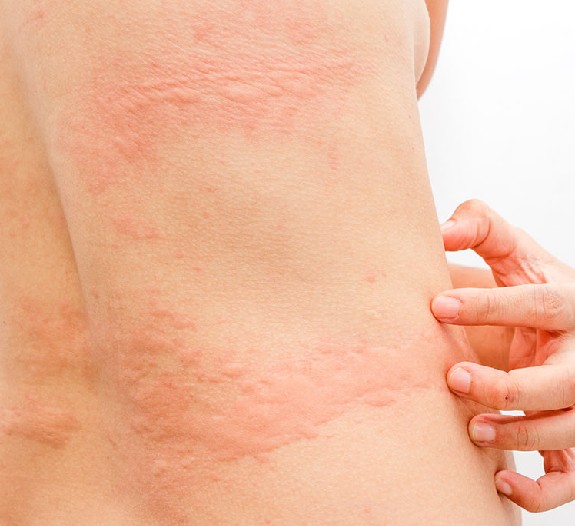
Types of Urticaria
1. Acute Urticaria
This outbreak of urticaria lasts less than six weeks and an underlying cause can be frequently identified and eliminated. The most common causes for acute urticaria are foods, drugs, or infections but in some cases, insect bites, internal diseases, pressure, cold, or sunlight also may be responsible.
• Foods
The most common foods that cause acute urticaria are nuts, chocolate, seafood, tomatoes, eggs, berries, and milk. Fresh foods cause hives more often than cooked foods. Sometimes, food additives and preservatives may also cause hives.
Urticarial lesion (hives) may appear within minutes to several hours after eating.
• Drugs
Almost any medication (with a prescription or over the counter), can cause acute urticaria. Antibiotics, pain medications, sedatives, tranquilizers, diuretics, diet supplements, antacids, arthritis medication, vitamins, herbal supplements, eye and ear drops, laxatives, vaginal douches, or any other non-prescription item can be a cause of an episode of urticaria. So, it is always important to inform the dermatologist regarding ALL medications (with prescription and over-the-counter), being used before the episode of urticaria, to help and find the cause of the hives.
• Infections
There are many infections that can cause urticaria. Viral upper-respiratory-tract infections are a common cause in children. Other numbers of bacterial and fungal infections, may cause urticaria.
2. Chronic Urticaria
We use this term when urticaria lasts for more than six months. The causes of chronic urticaria are more difficult to identify, a dermatologist reviews the entire medical history asks extensive questions, and conducts a thorough physical examination to find out the cause. Testing, such as blood investigations may be necessary for some patients.
3. Physical Urticarias
This form of urticaria may be caused by sunlight, heat, cold, water, pressure, vibration, or exercise. Solar urticaria appears within minutes of sun exposure and typically fades within a few hours. Cold urticaria appears when the skin is warmed after exposure to sudden cold. Urticaria, which appears in response to the cold or the water, can produce wheezing, flushing, generalized hives, and sometimes fainting.
4. Dermatographic Urticaria
This is also known as Dermatographism, which appears after firmly stroking or scratching the skin, and this can often occur with other forms of urticaria. It usually affects about five percent of the population. Most people with this condition are otherwise healthy. Dermatographic urticaria may last for months or even years.
5. Angioedema
This is a condition characterized by the sudden & temporary appearance of swelling in the subcutaneous tissue (layer below the skin) or submucosa usually in lips and around eyes. There can be difficulty in breathing, pain in the abdomen in severe cases if the internal organs are involved. Sometimes, this can be life-threatening and the patient has to be taken to the hospital immediately.
Allergy tests in Urticaria
Allergy tests may help to identify possible allergens that may trigger or aggravate episodes of urticaria but do not always provide a complete solution.
Treatment of Urticaria
The best treatment for urticaria is to find out and eliminate the cause whenever possible. Various types of antihistamines are prescribed to provide relief and work best if taken regularly to prevent hives from occurring. Not one antihistamine works for everyone, a dermatologist may use combinations of antihistamines to control the urticaria. In very severe cases, an injection of epinephrine (adrenalin) may be required. Sometimes, Cortisone may also bring fast relief, but its use must be limited to short periods of time. Urticaria is known to be chronic, recurrent and relapsing by nature. However, rash-free intervals up to many years are possible.
 Whatsapp
Whatsapp Facebook
Facebook Twitter
Twitter Instagram
Instagram Linkedin
Linkedin Pinterest
Pinterest